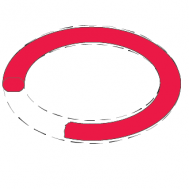O-Ring failure typically results from a combination of adverse effects and environmental factors. These complex combinations of stresses can be difficult to evaluate.
Among the most common causes of o-ring failure are:
- Improper gland design, resulting in compression set
- Incompatibility of o-ring elastomer and environmental elements
- Improper o-ring installation
- Incorrect o-ring size
Read on for a quick guide to the causes of and solutions to some of the most common o-ring failure patterns.
FAILURE PATTERN: COMPRESSION SET
Occurring in both static and dynamic seals, compression set failure creates flat surfaces on both sides of an o-ring’s cross section.
PROBLEM SOURCES
- Selection of an elastomer with poor compression set properties
- Low heat resistance
- Excessive swelling of o-ring in system fluid
- Too much squeeze
- Incomplete curing during production
- High operating temperature
POSSIBLE SOLUTIONS
- Selection of a low set elastomer
- Selection of an o-ring material with resistance to both operating and friction generated heat
- Verify compatibility of o-ring material and system chemicals
- Reduce squeeze if possible
- Inspect o-rings for quality prior to installation
- Employ a low-set elastomer or higher temperature rated material
FAILURE PATTERN: WEATHER OR OZONE CRACKING
This failure pattern occurs in seals exposed to ozone and air pollutants. It can be identified by the appearance of small cracks on the surface of the seal that are perpendicular to the direction of stress.
PROBLEM SOURCE
- Ozone breaking down polymer chains
POSSIBLE SOLUTION
- Employ o-ring elastomers that are resistant to ozone attack. Find the correct elastomers using the guide to the General Properties of O-Ring Elastomers
FAILURE PATTERN: INSTALLATION DAMAGE
Generally resulting from equipment or human error, this failure mode can be identified by the appearance of short cuts, notches, and skinned or peripherally peeled o-ring surfaces.
PROBLEM SOURCES
- Sharp edges on mating components of the o-ring gland
- Sharp threads over which the o-ring must pass during assembly
- Insufficient lead-in chamfer
- Oversized o-ring ID on piston
- Undersized o-ring ID on rod
- Twisting or pinching of o-ring during installation
- No lubrication during installation
SUGGESTED SOLUTIONS
- Break all sharp edges
- Cover threads with tubes or tape during o-ring installation
- Provide a 15-20° lead-in chamfer
- Use lubrication during installation process
- Install correctly sized o-rings (see next failure pattern for help with this)
FAILURE PATTERN: INCORRECT O-RING SIZE
The difference of even a few millimeters can result in an incomplete seal. Ensuring that your o-rings have the correct dimensions, and that they are made to the highest quality standards is critical to the success of a project. By using Apple Rubber’s o-ring size search tool or contacting our engineering department, you can simplify the process of finding and ordering the exact o-rings you need.
Need help preventing o-ring failure?
Get in touch with Apple Rubber engineers through our contact form.
